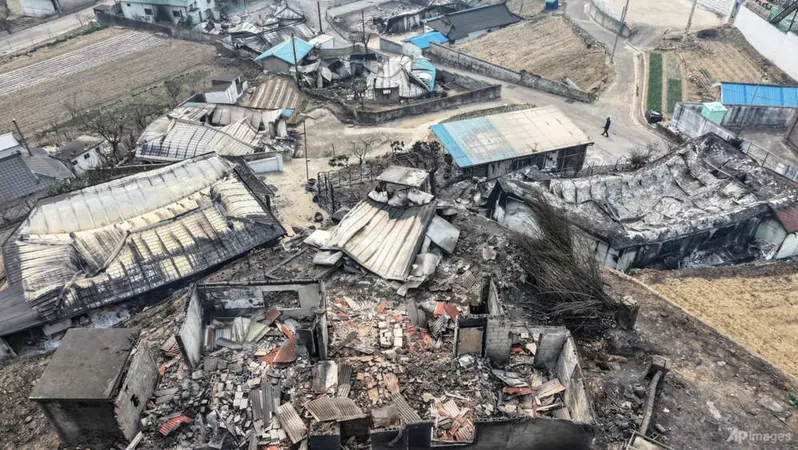
South Korea Faces Catastrophic Wildfires as Death Toll Reaches 26
2025-03-27
Author: Mei
In a tragic turn of events, South Korea is grappling with its worst wildfires on record, which have already claimed the lives of at least 26 individuals as of March 27, 2025. The wildfires have spread rapidly, doubling in size overnight and devastating the landscape, including historic temples. The main fire ignited in Uiseong County, engulfing over 33,000 hectares, marking it as the largest single forest fire incident in the nation’s history. This surpasses the previous record set in March 2000 when 24,000 hectares were scorched.
Acting President Han Duck-soo described the situation as 'nationally critical,' emphasizing the unprecedented speed at which the fires have spread. Among the deceased are numerous local residents and at least three firefighters. Tragically, a helicopter pilot lost his life when his aircraft crashed while battling the flames.
To bolster firefighting efforts, the South Korean military has supplied aviation fuel, enabling over 120 helicopters to douse flames across the mountainous regions of the southeastern part of the country, where bushfires have been raging for nearly a week. Given South Korea's rugged terrain, these helicopters play a crucial role in firefighting.
Disaster and safety division chief Lee Han-kyung highlighted how the wildfires have starkly illustrated the impacts of the climate crisis, noting that affected regions have received just half of their average rainfall this season. This follows a record-breaking hot year in 2024, where average temperatures reached 14.5 degrees Celsius—two degrees above the preceding 30-year average.
Experts have observed that the unprecedented spread of the Uiseong fire may be attributed to climate change, which is anticipated to contribute to increasingly frequent and severe wildfires worldwide. The Climate Central group reports that human-induced climate change is transforming seasonal dry conditions into highly flammable landscapes.
Andong city and adjacent regions, including Uiseong and Sancheong as well as Ulsan, are among the worst hit. Authorities had to evacuate residents from two villages in Andong, including Puncheon, which is home to Hahoe folk village—a UNESCO World Heritage Site founded in the 14th century. Hikers were also advised to abandon Jiri Mountain as flames spread alarmingly close.
Despite initial firefighting successes in controlling the flames, gusty winds and dry weather have allowed the fires to reignite and spread. Significant damages have been reported, including the destruction of homes, factories, and historic buildings. In Uiseong, the Gounsa temple complex—established in the 7th century—has lost approximately 20 of its 30 structures, including two state-designated treasures.
Meteorologists have forecasted minimal rain for the region, predicting less than five millimeters of precipitation, which officials believe will not substantially aid firefighting efforts. As the nation continues to battle these catastrophic wildfires, the focus remains on ensuring the safety of its residents and preserving its cultural heritage in the face of this natural disaster.


 Brasil (PT)
Brasil (PT)
 Canada (EN)
Canada (EN)
 Chile (ES)
Chile (ES)
 Česko (CS)
Česko (CS)
 대한민국 (KO)
대한민국 (KO)
 España (ES)
España (ES)
 France (FR)
France (FR)
 Hong Kong (EN)
Hong Kong (EN)
 Italia (IT)
Italia (IT)
 日本 (JA)
日本 (JA)
 Magyarország (HU)
Magyarország (HU)
 Norge (NO)
Norge (NO)
 Polska (PL)
Polska (PL)
 Schweiz (DE)
Schweiz (DE)
 Singapore (EN)
Singapore (EN)
 Sverige (SV)
Sverige (SV)
 Suomi (FI)
Suomi (FI)
 Türkiye (TR)
Türkiye (TR)
 الإمارات العربية المتحدة (AR)
الإمارات العربية المتحدة (AR)